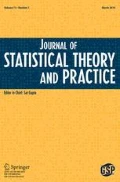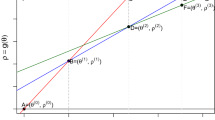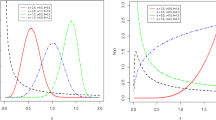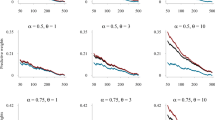Abstract
Recently, a proposal for simulating correlated discrete Weibull variables has been suggested, based on the Gaussian copula. Although the procedure is straightforward and allows the user to directly assign the desired pairwise correlations between the discrete margins (or simply assign the correlation matrix of the Gaussian copula), on the other hand the estimation process is more tricky. In this work, we describe and assess, with a special focus on the bivariate case, three techniques for the estimation of the model parameters; an application to real data is provided as well.
Similar content being viewed by others
References
Arbous, A. G., and J. E. Kerrich. 1951. Accident statistics and the concept of accident proneness. Biometrics 7 (4):340–432.
Barbiero, A. 2015a. DiscreteWeibull: Discrete Weibull distributions (Type 1 and 3), R package version 1.1. https://doi.org/CRAN.R-project.org/package=DiscreteWeibull.
Barbiero, A. 2015b. Simulating correlated discrete Weibull variables: a proposal and an implementation in the R environment. In International Conference of Computational Methods in Science and Engineering 2015, AIP conference proceedings 1702, eds. T. E. Simos, Z. Kalogiratou, and T. Monovasilis, 190017.
Barbiero, A. 2016. A comparison of methods for estimating parameters of the type I discrete Weibull distribution. Statistics and Its Interface 9 (2): 203–212.
Barbiero, A., and P. A. Ferrari. 2015a. GenOrd: Simulation of ordinal and discrete variables with given correlation matrix and marginal distributions, R package version 1.4.0. https://doi.org/CRAN.R-project.org/package=GenOrd.
Barbiero, A., and P. A. Ferrari. 2015b. Simulating correlated Poisson variables. Applied Stochastic Models in Business and Industry 31 (5):669–680.
Cario, M. C., and B. L. Nelson. 1997. Modeling and generating random vectors with arbitrary marginal distributions and correlation matrix. Technical report, Department of Industrial Engineering and Management Sciences, Northwestern University, Evanston, IL.
Englehardt, J. D., and R. C. Li. 2011. The discrete Weibull distribution: An alternative for correlated counts with confirmation for microbial counts in water. Risk Analysis 31: 370–381.
Englehardt, J. D. 2015. Distributions of autocorrelated first-order kinetic outcomes: Illness severity. PLoS ONE 10 (6):e0129042.
Ferrari, P. A. and A. Barbiero. 2012. Simulating ordinal data. Multivariate Behavioral Research 47 (4): 566–589.
Genest, C., and J. Nešlehová. 2007. A primer on copulas for count data. Astin Bulletin 37 (2):475–515.
Joe, H. 2005. Asymptotic efficiency of the two-stage estimation method for copula-based models. Journal of Multivariate Analysis 94 (2):401–419.
Kocherlakota, S., and K. Kocherlakota. 1992. Bivariate discrete distributions. New York, NY: Marcel Dekker.
Nakagawa, T., and S. Osaki. 1975. The discrete Weibull distribution. IEEE Transactions on Reliability 24 (5):300–301.
Nikoloulopoulos, A. K. 2013. Copula-based models for multivariate discrete response data. In Copulae in mathematical and quantitative finance, Lecture notes in statistics, ed. P. Jaworski, F. Durante, and W. Härdle, vol. 213, 231–49. Berlin, Heidelberg, Germany: Springer.
Padgett, W. J., and J. D. Spurrier. 1985. Discrete failure models. IEEE Transactions on Reliability 34 (3):253–256.
R Core Team 2016. R: A language and environment for statistical computing. R Foundation for Statistical Computing, Vienna, Austria. https://doi.org/www.R-project.org.
Stein, W. E., and R. Dattero. 1984. A new discrete Weibull distribution. IEEE Transactions on Reliability 33 (2):196–197.
Author information
Authors and Affiliations
Corresponding author
Rights and permissions
About this article
Cite this article
Barbiero, A. Estimating a multivariate model with discrete Weibull margins. J Stat Theory Pract 11, 503–514 (2017). https://doi.org/10.1080/15598608.2017.1292483
Received:
Accepted:
Published:
Issue Date:
DOI: https://doi.org/10.1080/15598608.2017.1292483




